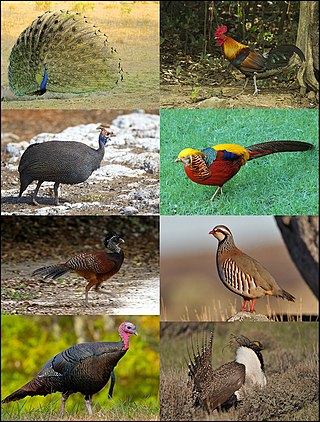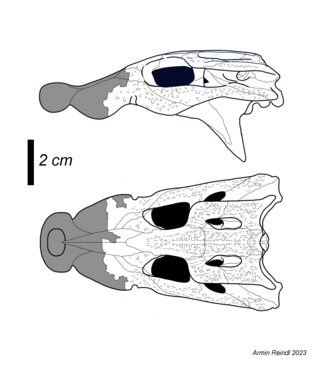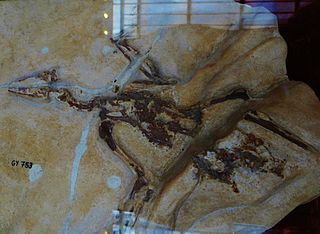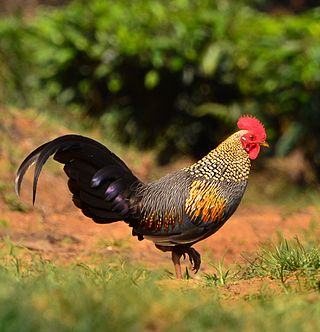
Pheasants are birds of several genera within the family Phasianidae in the order Galliformes. Although they can be found all over the world in introduced populations, the pheasant genera native range is restricted to Eurasia. The classification "pheasant" is paraphyletic, as birds referred to as pheasants are included within both the subfamilies Phasianinae and Pavoninae, and in many cases are more closely related to smaller phasianids, grouse, and turkey than to other pheasants.

Grouse are a group of birds from the order Galliformes, in the family Phasianidae. Grouse are presently assigned to the tribe Tetraonini, a classification supported by mitochondrial DNA sequence studies, and applied by the American Ornithologists' Union, ITIS, International Ornithological Congress, and others.

The turkey is a large bird in the genus Meleagris, native to North America. There are two extant turkey species: the wild turkey of eastern and central North America and the ocellated turkey of the Yucatán Peninsula in Mexico. Males of both turkey species have a distinctive fleshy wattle, called a snood, that hangs from the top of the beak. They are among the largest birds in their ranges. As with many large ground-feeding birds, the male is bigger and much more colorful than the female.

Fowl are birds belonging to one of two biological orders, namely the gamefowl or landfowl (Galliformes) and the waterfowl (Anseriformes). Anatomical and molecular similarities suggest these two groups are close evolutionary relatives; together, they form the fowl clade which is scientifically known as Galloanserae or Galloanseres. This clade is also supported by morphological and DNA sequence data as well as retrotransposon presence/absence data.

Galliformes is an order of heavy-bodied ground-feeding birds that includes turkeys, chickens, quail, and other landfowl. Gallinaceous birds, as they are called, are important in their ecosystems as seed dispersers and predators, and are often reared by humans for their meat and eggs, or hunted as game birds.

The Phasianidae are a family of heavy, ground-living birds, which includes pheasants, partridges, junglefowl, chickens, turkeys, Old World quail, and peafowl. The family includes many of the most popular gamebirds. The family is a large one and includes 185 species divided into 54 genera. It was formerly broken up into two subfamilies, the Phasianinae and the Perdicinae. However, this treatment is now known to be paraphyletic and polyphyletic, respectively, and more recent evidence supports breaking it up into two subfamilies: Rollulinae and Phasianinae, with the latter containing multiple tribes within two clades. The New World quail (Odontophoridae) and guineafowl (Numididae) were formerly sometimes included in this family, but are now typically placed in families of their own; conversely, grouse and turkeys, formerly often treated as distinct families, are now known to be deeply nested within Phasianidae, so they are now included in the present family.

Guineafowl are birds of the family Numididae in the order Galliformes. They are endemic to Africa and rank among the oldest of the gallinaceous birds. Phylogenetically, they branched off from the core Galliformes after the Cracidae and before the Odontophoridae. An Eocene fossil lineage Telecrex has been associated with guineafowl; Telecrex inhabited Mongolia, and may have given rise to the oldest of the true phasianids, such as blood pheasants and eared pheasants, which evolved into high-altitude, montane-adapted species with the rise of the Tibetan Plateau. While modern guineafowl species are endemic to Africa, the helmeted guineafowl has been introduced as a domesticated bird widely elsewhere.

Galloperdix is a genus of three species of bird in the pheasant family, Phasianidae. These terrestrial birds are restricted to the Indian Subcontinent, with the red spurfowl and painted spurfowl in forest and scrub in India, and the Sri Lanka spurfowl in forests of Sri Lanka. They share the common name "spurfowl" with the members of the genus Pternistis which are widely distributed in Africa.

Francolins are birds in the tribe Gallini that traditionally have been placed in the genus Francolinus, but now commonly are divided into multiple genera.
Paramachaerodus is an extinct genus of saber-tooth cat of the subfamily Machairodontinae, which was endemic to Europe and Asia during the Middle and Late Miocene from 15 to 9 Ma. A 2022 phylogenetic analysis suggested that the genus may be polyphyletic.

Trilophosuchus is an extinct genus of mekosuchine crocodilian from Australia. Its fossils have been found at the Ringtail Site in the Riversleigh World Heritage Area and date to the Miocene epoch. Additional remains have also been found at the older Hiatus Site and extend its range into the Oligocene. Like the closely related Mekosuchus, it is thought to have had a short and blunt snout and large eyes that generally resembles today's dwarf crocodiles. It also shares similarities with several much older crocodylomorph groups and is commonly thought to have been more terrestrial than any crocodilian living today. Only a single species has been described, the type species T. rackhami.

The crimson-headed partridge is a species of bird in the pheasant, partridge, and francolin family Phasianidae. Described by the British ornithologist Richard Bowdler Sharpe in 1879, it is the only species in the genus Haematortyx. It is endemic to Borneo, where it inhabits lower montane forest in the northern and central parts of the island. It is mainly found at elevations of 1,000–1,700 m (3,300–5,600 ft), but can be seen as low as 185 m (607 ft) and as high as 3,050 m (10,010 ft). Adult males have a striking appearance, with a dark blackish body and crimson red heads, necks, breasts, and undertail coverts. Females have a similar pattern, but with duller brownish-black colouration, orangish-red heads and breasts, and a brownish-black bill instead of a yellowish one. Juveniles are duller and have the crimson restricted to the top of the head.
Amitabha urbsinterdictensis is an ancient bird from the Middle Eocene in North America. One specimen has been found to date. Bonnie Gulas-Wroblewski and Anton Wroblewski described and named it in 2002.

The Phasianinae are a subfamily of the pheasant family (Phasianidae) of landfowl, the order Galliformes. The subfamily includes true pheasants, tragopans, grouse, turkey and similar birds. Although this subfamily was considered monophyletic and separated from the partridges, francolins, and Old World quails (Perdicinae) till the early 1990s, molecular phylogenies have shown that this placement is paraphyletic. For example, some partridges (genus Perdix) are more closely affiliated to pheasants, whereas Old World quails and partridges from the genus Alectoris are closer to junglefowls. There are two clades in the Phasianinae: the erectile clade and the non-erectile clades. Both clades are believed to have diverged during the early Oligocene, about 30 million years ago.

Palaeortyx is an extinct genus of granivorous galliform bird that lived 28.4 to 2.588 million years ago. It lived from the early Eocene to the early Pliocene, and may be a phasianid or odontophorid. It is known from several fossils found in Germany, France, Italy, Hungary and Romania.

Pangalliformes is the scientific name of a provisional clade of birds within the group Galloanserae. It is defined as all birds more closely related to chickens than to ducks, and includes all modern chickens, turkeys, pheasants, and megapodes, as well as extinct species that do not fall within the crown group Galliformes.

Panraogallus is an extinct genus of phasianid bird from the Late Miocene of what is now China. The holotype specimen was discovered in the Liushu Formation near the Zhuangkeji Township in Guanghe County, Gansu Province. The specimen consists of an almost complete skeleton of a young adult, though part of the skull and the neck vertebrae were reconstructed in plaster before the specimen was acquired by the Hezheng Paleozoological Museum. The specimen also preserves an elongated, coiled trachea, the oldest known bird fossil with such a structure. The specimen was made the basis of the new genus and species Panraogallus hezhengensis by the Chinese palaeontologist Zhihen Li and colleagues in 2018. The generic name is the pinyin of the Chinese characters for "coiling" and Latin for "chicken", which refers to the elongated trachea; "coiled chicken" in full. The specific name refers to the Hezheng area, where abundant specimens of this bird have been found.

Asteriornis is an extinct genus of bird from the Late Cretaceous of Belgium which is known from a single species, Asteriornis maastrichtensis. It was closely related to birds of the extant superorder Galloanserae such as chickens and ducks. Members of the genus were small, long-legged birds that lived near the coastline and co-existed with more "primitive" types of birds such as Ichthyornis. Asteriornis is one of the oldest-known birds irrefutably belonging to the group Neornithes, which encompasses all modern birds. It possesses characteristics of both galliformes and anseriformes, indicating its position as a close relative of the last common ancestor for both groups.

Ortygornis is a genus of birds in the francolin group of the family Phasianidae.
Palaealectoris is an extinct monotypic genus of landfowl, belonging to the family Tetraonidae, distantly related with modern grouses. Its fossilized remains, found in the Marsland Formation, a part of the Agate Fossil Beds National Monument in Nebraska, and in the Calvert Formation in Maryland, are dated from the Early Miocene.



















